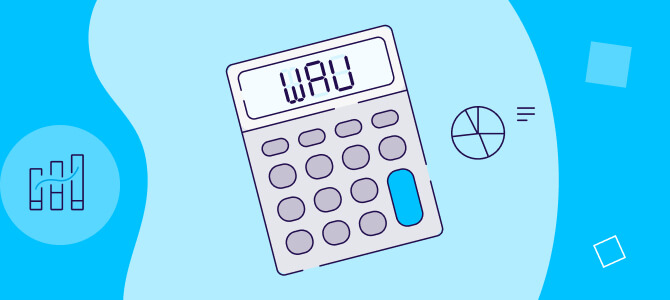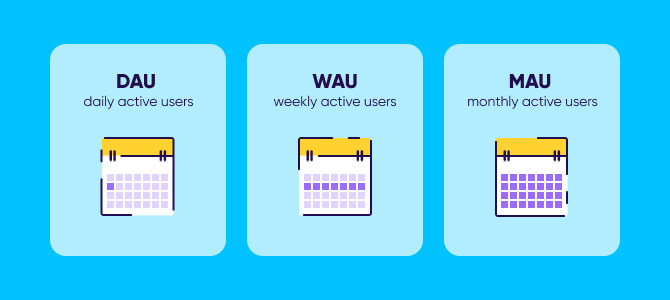
Weekly active users (WAU)
The number of unique users that engage with your app within a 7-day window. WAU is generally used by businesses where users are expected to interact with the app at a weekly frequency (e.g. analytics tools).
What are weekly active users (WAU)?

Active users are individuals who engage with your app over a given time period. This could be making a transfer (online banking), adding to cart (ecommerce), downloading or logging into the app (SaaS) — or really any activity that meets your company’s definition of “active” user activity.
WAU is the metric used to track weekly user engagement, including new and existing users.
You can identify your app’s weekly active users through a personal unique identifier like email addresses, IDFA (for consenting iOS 14+ users), and user IDs. In fact, app marketers often use a combination of these as backup in case one fails.
How to calculate WAU?

Here’s the formula:
Total number of unique active users that interacted with your mobile app within the last seven days, starting on the designated day
Now, let’s review how to apply the formula in real life:
- Define your criteria for an active user, including the specific in-app actions the user would take.
- Define the frequency of the engagement you want to measure (WAU in our case).
- Collect the data using an analytics tool of your choice, and add the number of unique users who meet your active user criteria for the selected week.
Here’s an example:
- Criteria of an active user — Anyone who clicks a button, swipes, or scrolls.
- Frequency of engagement — WAU
- Throughout the week, the following engagements were registered:
- User 1 logged into the app and clicked the button
- User 2 logged into the app but remained idle
- Use 3 scrolled and swiped, and then closed the app
- User 1 logged into the app again and clicked another button
- User 4 clicked a button and then closed the app
- Bottom line: Your WAU here is 3.
- User 1 is an active user (counted once)
- User 2 is an inactive user
- User 3 is an active user
- User 4 is an active user
Note that defining your active users — which is the most critical aspect of calculating WAU — will be unique for every business goal.
If your objective is to get more app users, your active user measurement would be the number of unique users that log into your app. But if your key objective is to boost revenue, your active users would be the number of unique users making a purchase on your app over a given period.
Different business goals = Different active user criteria
WAU, DAU, MAU

Active user metrics are of three types. Aside from WAU, you should also track the following two categories:
Daily Active Users (DAU):
The number of unique visitors that engage with your app within a 24-hour window. Primarily used by businesses where users are expected to interact with the app daily (e.g. gaming).
Monthly Active Users (MAU):
The number of unique visitors that engage with your app within a 30-hour window. Primarily used by travel or finance apps where users typically interact with the app a few times a month or less.
Why should you use WAU?
An increasing volume of active users is always a good sign. It’s proof you’re doing something right. But besides the feel-good factor, using WAU also has several other benefits:
Measuring app success
A successful app is one that customers use and engage with on a regular basis. But not every app is a success, especially considering 80%-90% of mobile apps are abandoned after a single use.
Tracking WAU (along with DAU and MAU) will help you determine whether your users find your app worthy of their time, and take necessary precautions if needed, like building new updates and removing bugs to improve user experience.
Gauge customer engagement
WAU tells you whether users are having ongoing meaningful interactions with your app.
Consistently high WAU numbers indicate customers are likely to upgrade their subscriptions or can be persuaded to subscribe to add-ons. You can customize in-app experiences based on their needs to leverage business opportunities and boost company revenue.
Determine app stickiness
An app’s stickiness is determined by the extent to which users engage with it regularly. The stickier your app, the more users will keep coming back to it.
Marketers typically divide DAU by MAU to calculate app stickiness, but you can substitute MAU with WAU to know stickiness for any given week.
You can then determine whether users are finding your app valuable and relevant to their lives, and uncover opportunities to monetize through in-app advertising or in-app purchases.
How to increase WAU

Creating a winning app engagement strategy requires tact and leveraging multiple channels like push notifications, in-app messages, email, and deep linking.
Here are a few tips to seamlessly harness all these channels and ramp up your WAU rates:
1 – Push notifications
These are one of the most effective ways to engage app users. Use push notifications to deliver important information anytime, anywhere. But if misused, they can also generate more uninstalls.
While you’ll find various push notifications best practices and benchmarks on the internet, the burning question to consider here is whether you’re offering actual value to your audience.
Instead of sending several messages, use personalized and relevant communication to improve user experience, and regularly monitor your push notification statistics to understand what’s working and what’s not.
2 – In-app messages
Ideally, you should align app experience with your user’s needs and preferences. The better the alignment, the more likely they are to continue using your app and boost your WAU.
In fact, research suggests brands using personalized in-app messages experience 61%-74% of retention rates within 28 days of sending the message. On the flip side, brands sending (mostly) generic campaigns have drastically lower retention rates at just 49% within the same timeframe.
Interestingly, in-app messages aren’t intended for communicating immediate calls to action. But considering the greater convenience, marketers are increasingly using them to send important notifications and warnings like payment failures, app issues, and version upgrades.
You can also segment your audience based on factors (geographical region, usage, history) and send tailored messages with real-time updates and links to personalized content.
3 – Email
Retention depends on your ability to keep your app top of mind for your users — and keep them coming back for more.
After downloading the app, users will need some guidance to tap into its full potential. Create an effective and seamless onboarding process that sends them the right mix of emails to keep them engaged and simultaneously improve WAU rates.
For instance, you can use emails to reconnect with users that were once active but have now stopped using your app. It’s the least intrusive way to notify them about the latest updates and encourage them to start using your app again.
Similarly, a user who was once active for a week straight but hasn’t opened your app for the past few days might appreciate receiving an SMS with a link to an in-app trending blog post.
Effective audience segmentation is key here — and makes all the difference between an idle to an engaged user.
4 – Deep linking
Imagine this: you’ve created the perfect email. It’s personalized, relevant, and has an irresistible offer that will surely inspire action. But when users click on your given link, they are directed to your app’s general home screen.
There goes all your effort.
So what should you do instead?
Implement attribution-fuelled deep linking as part of your cross-channel strategy. Link your siloed channels into a single cohesive user experience platform to deliver a consistent, hassle-free experience that allows users to go through their individual user journeys.
This approach will not only remove the different obstacles along the user journey but also put you in a better position to create long-lasting relationships with users and strengthen your competitive edge.
Key takeaways
- In the app world, WAU is the number of unique users that engage with your app within any given week, and is typically used by businesses where users interact with the app on a weekly basis.
- Having an explicit definition of active users for your business is extremely crucial for calculating WAU. You should consider your individual business goals to determine this criterion.
- The increase or decrease in WAU is directly proportional to app success, customer engagement, and app stickiness.
- To ramp up your WAU rates, your app engagement strategy should combine cross-channel efforts. Leverage email, post notifications, in-app notifications, and deep linking — to offer users tangible and personalized value, which will eventually boost engagement and retention.



